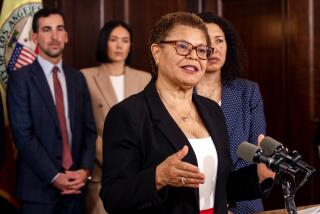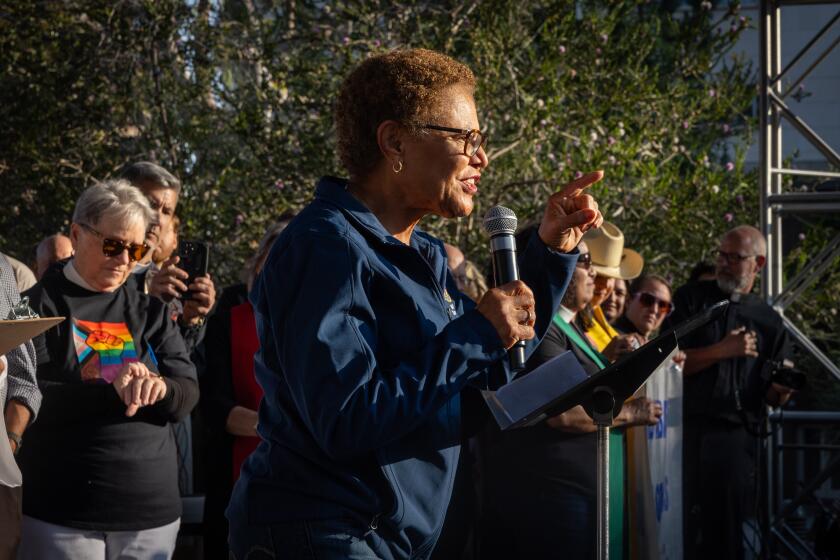Creditor Panel Wants County to Raise Taxes
- Share via
SANTA ANA — New revenue--probably from tax hikes--must be pledged to support bonds as part of Orange County’s recovery plan, the county’s bankruptcy creditors committee states in a report that is highly critical of the county’s response so far to its unprecedented financial crisis.
In a 40-page package provided to county officials last week, the committee representing vendors and bondholders provides the most detailed picture yet of potential revenue streams for the beleaguered county, which Dec. 6 became the largest municipality in history to file for bankruptcy protection.
Along with a half-cent increase in the county’s sales tax, the creditors committee outlines the possibilities for utility taxes, asset sales and an innovative proposal to set aside all property taxes above the current level to back new bonds.
Those ideas combined would enable the county to issue between $2.5 billion and $6.8 billion in new debt, far more than the stunning $1.7 billion plunge suffered by its high-flying investment pool last year.
“This is basically intended to be a menu of a whole lot of alternatives. If all of these options were used together it could plug a much bigger hole than we even have,” said Robert Moore, an attorney representing the creditors committee.
“Revenue is going to be needed not just to solve the problem of the creditors of the county and the pool, but additionally to solve the problems of operating deficits” created by the loss of millions in anticipated interest, Moore said Saturday. “The county, in essence, has been living beyond its means for years.”
The creditors committee and county officials are currently engaged in secret negotiations over possibilities for recovery. The creditors committee presentation provides the first peek at the ideas being considered.
County bankruptcy attorney Bruce Bennett has repeatedly refused in recent weeks to comment on recovery proposals, and could not be reached Saturday. Supervisors Marian Bergeson and William G. Steiner said Saturday they had not seen the creditors’ report. Other supervisors could not be reached for comment.
During the two months since the crisis began, members of the Board of Supervisors have insisted that new taxes are out of the question. But economic experts, including the underwriters hired by the supervisors to help them restructure the county’s debt and issue more, have indicated that new revenue will be a crucial component of any recovery plan.
New revenue streams, experts say, would help boost confidence on Wall Street, where the county’s once-stellar credit rating has plunged along with the value of its investment portfolio.
In the creditors’ report, financial advisers Chanin and Company and Sutro & Co. criticize the county for not providing them with financial data, audits, debt service statements, budget documents and an analysis of transactions in the investment pool the county managed for 186 cities, schools and special districts. The committee also blasts county leaders for being short-sighted and refusing to consider some of its options, such as taxes.
“We believe that it will be extremely difficult, if not impossible, for the county to address the . . . loss solely through budget cuts and deferral of capital projects,” the report states. “To date, the county and its advisers have been focusing on short-term budgeting issues, and have outlined a very limited universe of specific permanent solutions. . . . By stating that they will not consider raising taxes . . . the county is eliminating an option which should be seriously considered in ordered to preserve Orange County’s reputation as a desirable location in which to live.”
The creditors committee does not rank its proposed solutions, but simply lays out the details of each.
The newest notion in the package is a “property tax bond issue,” in which the county would not raise taxes, but would pledge any growth in the current property tax base to cover a new bond issue. Special legislation would be required for such a plan.
The creditors estimate that if assessed valuations grow 2% a year, the county could raise nearly $1.5 billion in bond proceeds over five years. The proceeds could be as high as $3 billion over five years if the valuations grow 4% a year, according to the creditors committee.
But the plan could fall apart if property values do not increase. While the average annual increase over the past decade has been 7.4%, values have dropped each of the past two years.
The presentation also includes a more detailed look at a half-cent hike in the 7.75% sales tax, which many have suggested as a partial solution to the crisis. Such a move would require approval by four of the five supervisors and a majority of the county’s voters, and could not take effect until March, 1996, without a special election.
The creditors note in their presentation that such an increase would amount to a per capita burden of about $1 a week for Orange County residents, and that nine California counties--including Los Angeles--already have sales taxes of 8.25% or higher. They estimate that a half-cent hike would allow the county to issue more than $1 billion in new bonds.
“That is one measure that could go very far to addressing all of the problems,” Moore said.
Though the property tax and sales tax proposals are the largest revenue-raisers, the creditors also outline a number of smaller ideas that could combine to form a solution.
Without voter approval, the county could impose taxes on electricity, gas, telephone and cable services, which the creditors say would raise $10 million to $30 million a year. That could be used to issue $90 million to $110 million in new bonds.
But, the committee notes, “a utility tax would probably have a greater impact on businesses in the county and may impact economic development.”
The only option outlined in the presentation that has also been openly considered by county officials is the sale or lease of various county assets. County officials estimate they could raise about $51 million by selling property other than John Wayne Airport.
The creditors suggest that the county could use its property assets as collateral to issue between $100 million and $300 million in Certificates of Participation.
In the presentation, the creditors echo outside Wall Street experts that have said previously that state intervention will be essential to the county’s recovery. They outline similar situations in New York and Pennsylvania in which the state stepped in to guarantee a revenue stream for bonds issued by local governments wracked by financial disaster.
Because some of the proposed solutions, such as a sales tax, would take time to implement, the creditors also suggest short-term debt restructuring, such as a loan from the state or an outside third party, or an extension of the county’s current debt payments.
More to Read
Sign up for Essential California
The most important California stories and recommendations in your inbox every morning.
You may occasionally receive promotional content from the Los Angeles Times.













